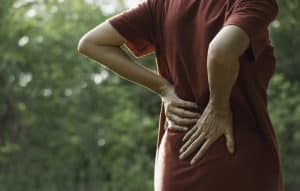All About Back Pain
August 15, 2021

When you come to see us at Southside Pain Specialists, we have many treatment options for back pain. A wonderful new option we have is our WaveWriter Alpha spinal cord stimulator system. Spinal cord stimulators send mild electrical impulses to disrupt the pain messages sent to the brain. We implant these small devices near the spine to control these impulses.
Here is more information about back pain symptoms, risk factors, and treatment.
Back Pain Symptoms, Causes, Risk Factors, Prevention, & Treatment
Symptoms
Back pain can range from aching muscles to a shooting, burning or stabbing sensation. The pain may radiate down your leg or worsen with bending, twisting, lifting, standing, or walking.
When back pain does not improve with home care, contact us if your back pain:
- Persists past a few weeks
- Is severe and doesn’t improve with rest
- Spreads down one or both legs, especially if the pain extends below the knee
- Causes weakness, numbness, or tingling in one or both legs
- Is accompanied by unexplained weight loss
Causes
We may be able to diagnose back pain after asking about your symptoms and carrying out a physical examination. However, back pain often develops without a cause that we can identify without a test or an imaging study.
There are many conditions commonly linked to back pain, such as:
- Muscle or ligament strain. Repeated heavy lifting or a sudden awkward movement can strain back muscles and spinal ligaments. If you’re in poor physical condition, constant strain on your back can cause painful muscle spasms.
- Bulging or ruptured disks. Disks act as cushions between the bones (vertebrae) in your spine. The soft material inside a disk can bulge or rupture and press on a nerve.
- Arthritis. Osteoarthritis can affect the lower back. In some cases, arthritis in the spine can lead to a narrowing of the space around the spinal cord, a condition called spinal stenosis.
- Osteoporosis. Your spine’s vertebrae can develop painful fractures if your bones become porous and brittle from osteoporosis.
Risk Factors
Anyone can develop back pain, including children and teens. There are certain factors that might put you at greater risk of developing back pain, including:
- Age. Back pain is more common as you get older, starting around age 30 or 40.
- Lack of exercise. Weak, unused muscles in your back and abdomen might lead to back pain.
- Excess weight. Excess body weight puts extra stress on your back.
- Diseases. Some types of arthritis and cancer can contribute to back pain.
- Improper lifting. Using your back instead of your legs can lead to back pain.
- Psychological conditions. People prone to depression and anxiety appear to have a greater risk of back pain.
- Smoking. Smokers have increased rates of back pain. This may occur because smoking prompts more coughing, which can lead to herniated disks. Smoking can also decrease blood flow to the spine and increase the risk of osteoporosis.
Prevention
The first defense should always be to prevent back pain altogether or to prevent it from recurring. There are many strategies for keeping your back healthy and strong, which can help improve back pain.
- Exercise. Regular low-impact aerobic activities, meaning those that don’t strain or jolt your back, can increase strength and endurance in your back and allow your muscles to function better. Walking and swimming are good choices.
- Build muscle strength and flexibility. Abdominal and back muscle exercises, which strengthen your core, help condition these muscles so that they work together to support your body better.
- Maintain a healthy weight. Being overweight strains back muscles. If you’re overweight, trimming down can prevent back pain.
- Quit smoking. Smoking increases your risk of low back pain. The risk increases with the number of cigarettes smoked per day, so quitting should help reduce this risk.
- Sit the right way. Good posture when sitting can reduce the stress on back muscles. Choose a seat with good lower back support, armrests, and a swivel base. Keep your knees and hips level. Change your position frequently, at least every half-hour.
- Lift smart. Avoid heavy lifting, if possible, but if you must lift something heavy, let your legs do the work. Keep your back straight (no twisting) and bend only at the knees. Hold the load close to your body. Find a lifting partner if the object is heavy or awkward.
Back Pain Treatment at Southside Pain Specialists
When back pain does occur and persist, we have many treatment options that can help us find and diagnose the problem and treat it. It’s often a combination of approaches, such as medications, physical therapy, and treatment procedures that produce the best results. Every one of our patients is unique, and treatment plans will be unique as well.
Start your pain management journey by scheduling an appointment at Southside Pain Specialists
With highly specialized training and a multitude of pain relief options, Southside Pain Specialists follow the standards of the American Society of Interventional Pain Physicians, The American Board of Pain Medicine, and the International Spinal Injection Society. We work hard to provide patients with comprehensive, caring pain relief when they need it most. Check out our website or contact us today at 205.332.3155 to learn more.
